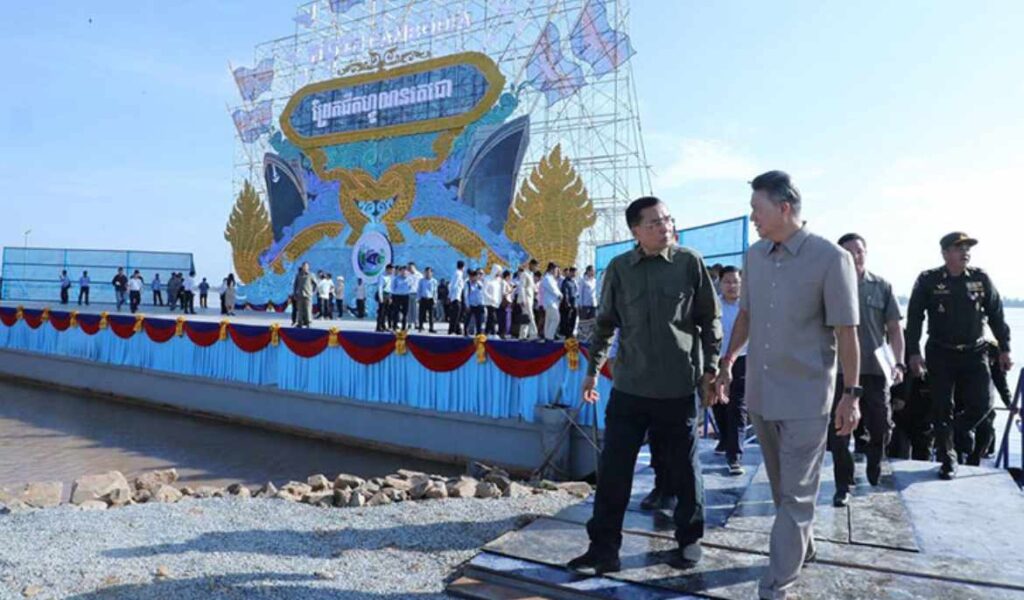The Royal Government Friday unveiled details of the Public Private Partnership (PPP) contract worth $1.156 billion between Cambodian and Chinese companies for the development of the Funan Techo Canal (FTC) project, structured under a 51-49 percent ownership model.
The budget disclosure came a day after the agreement was formally signed by Sun Chanthol, Deputy Prime Minister and First Vice-Chairman of the Council for the Development of Cambodia (CDC), and Leng Sunly, representative of the Funan Techo Coastal-Inland Waterways Company Ltd, in Phnom Penh on April 17.
According to the FTC press release, the $1.156 billion PPP agreement represented a transformative infrastructure project aimed at modernising Cambodia’s waterway transport system, bolstering economic self-reliance and enhancing regional connectivity.
The project is being developed under a Build-Operate-Transfer (BOT) model following Cambodia’s PPP law with local investors holding a 51 percent equity stake to ensure majority national ownership while Chinese partners hold the remaining 49 percent, the statement added.
Sharing the details of the signing ceremony, Chanthol highlighted that the PPP contract reflects the strong collaboration between the Royal Government and the Funan Techo Coastal-Inland Waterways Company Ltd, a special-purpose company jointly owned, with 51 percent held by Cambodian firms and 49 percent by China Road and Bridge Corporation.
The Deputy Prime Minister noted that the three domestic stakeholders, namely the Overseas Cambodian Investment Corporation (OCIC), Sihanoukville Autonomous Port (PAS), and Phnom Penh Autonomous Port (PPAP), collectively hold the majority share.
Chanthol described the Funan Techo Canal as a historic project for Cambodia, scheduled to be constructed over a four-year period. He called on all relevant development partners and provincial governors to work together to ensure timely completion.
“I look forward to the successful implementation and on-schedule completion of this project by 2028, in accordance with the Royal Government’s plan,” he said.
During his remarks, Wang Tongzhou, Chairman of China Communications Construction Company (CCCC), the parent company of CRBC, said that the project would enhance Cambodia’s overall competitiveness. “More importantly, it marks a significant milestone in deepening cooperation between the two nations,” he said.
Wang emphasised that the Kingdom is one of CCCC’s most important strategic markets in Southeast Asia, demonstrated by its dynamic growth and sustained social progress.
“This inland waterway will serve as a new engine for Cambodia’s economic development. Once completed, it will significantly reduce logistics costs, increase the competitiveness of local products, and support industrial operations in moving up the value chain toward medium- and high-end segments,” he added.
Speaking to Khmer Times, Hong Vanak, an economic researcher at the Royal Academy of Cambodia (RAC), explained that the 51-49 percent ownership model refers to a joint venture between Cambodian and Chinese companies, consistent with international practices adopted by countries such as Thailand, Vietnam and other regional and global partners.
Vanak noted that under this structure, with 51 percent held by local companies and 49 percent by a foreign investment firm, key decisions and operations are managed by the domestic side while the foreign partner receives profit shares based on its ownership stake.
“This arrangement allows the majority stakeholder to assume the role of chairman of the board while the minority stakeholder typically takes on the role of deputy chairman.”
As a result, Cambodia will be in a position to lead decision-making during the project’s implementation while also consulting with Chinese investors to ensure strategic alignment and successful outcomes, he added.



